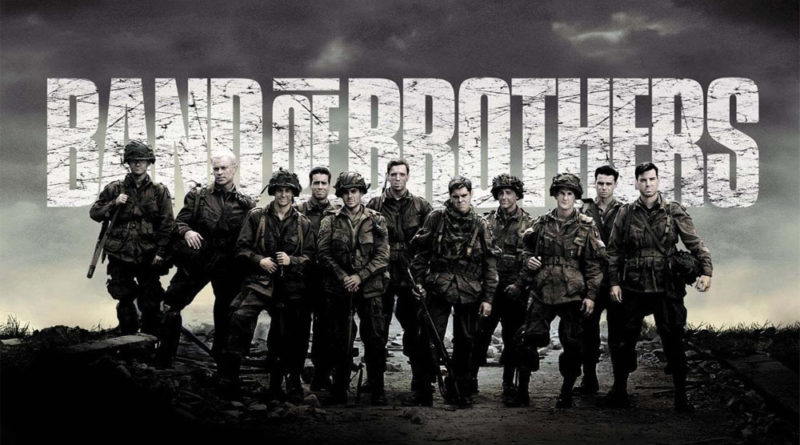Why We Fight
In this episode, the members of Easy Co. make a gruesome discovery near the town of Landsberg, Germany; Kaufering IV. Kaufering IV is a subcamp of the larger Dachau concentration camp .
The holocaust itself evokes many profound questions about human nature, and the nature of human conflict. For the purpose of this discussion, we will attempt to focus on the immediate themes relating to our roles as leaders in situations of conflict. An important place to begin is with an understanding of bias; specifically In-Group Bias, aka In-group/Out-Group.
In short, In-Group Bias is the tendency for people to favor those within a their perceived group over those who are outside of the group. The simplest example can be seen with fans of a particular sports team vs those of another team. This type of bias lays the groundwork for thoughts, ideas, words, and actions that separate and divide people. Words such as "them" and "those people" are simple indicators of bias. The root of the problem with In-Group bias is that it forms the foundation of human conflict.
Simple disagreements transition quickly from:
"I'm right, you're wrong"
to...
"I'm right and there is something wrong with you because you don't agree with me"
to eventually...
"I'm right, therefore I'm good...and you're wrong, therefore you're evil"
Now, this is definitely an oversimplification of very complex concepts. How does this relate to our role as leaders?
Leaders Unite, they don't Divide.
Bottom line...leaders are responsible for bringing people together, not driving them apart. A key step to being able to accomplish this is to be able to identify In-group Bias within an organization, and to work diligently to minimize differences and maximize similarities.
Discussion questions to consider...
- Are there different "groups" within our/your organization?
- How can In-group Bias impact the culture of an organization as a whole?
- What are some ways leaders can bring "groups" together?
- Which other types of bias inhibit positive leadership?

There are certainly different groups of people within our organization. Motivated groups, unmotivated groups, groups that want to effect change, groups that complain about change, groups that look out for others in all areas of life and groups that simply worry about themselves.
ReplyDeleteIn-group bias IS our culture as a whole. Before my time in the organization, throughout my time and every other organization around the country had the same culture. I feel the question should be more how do we change our culture to have any group believe in the same vision? I was told recently “thats our culture” when a group of people wanted to talk about the impression of a rookie FF without talking to the rookies Captain. That is our culture but is it right? To me it is not. The group would rather fall into the culture and “eat our own” rather than be constructive and involve the rookies Captain so the behavior can be addressed. The issue with in-group bias is the negativity than comes from discussion. It affects the minds of others to fall into that negativity. The good thing is we have proactive, motivating groups that want to promote positivity and pride in the organization. This creates a positive atmosphere and engages others to re-direct negative conversations to become positive ones.
Leaders can bring groups together with engagement, empowerment and information. Find what motivates people. What are they passionate about? What skills do they have that can benefit the organization? Once they realize that, they can begin to teach and train others. An example would be Ryan Pourhassanian and his ability to engage others in a classroom on a skill he is deeply passionate about.
When leaders give all the information to a group it brings the group together to be on the same page and leaves little room for gossip or negativity. Take organizational change for example. When our leaders give all the information of a certain vision and the positive impact it will have on the community it allows for discussion. Discussion amongst all ranks for better understanding and allows everyone to feel apart of positive change, empowers even the lowest FF to lead the organization to be a better place.
Other bias that can inhibit leadership is or own personal bias. As John Maxwells book “developing the leader in you 2.0” one of the hardest people to ever lead is ourselves. Sometimes we need to put aside or own personal bias for the benefit of the organization. Its not easy, but we who are servant leaders know the benefit of serving others before ourselves.
In my experience, organizations will have sects within them. Most people will be good representations, or try to be, of the Mission and Vision. The sects could represent shifts. During my time at Montebello each shift had its own Mission and Vision and Values. I've witnessed similar characteristics within the churches I've been apart of, in that while everyone believe in Jesus, they held the ministry in which they served (children, youth, evangelism, worship, etc.) higher than the other ministries in the church.
ReplyDeleteAny sect, or bias within an organization/team can lead people away from the MVV. It could also drive a wedge between the sects/shifts/deparments/etc. The leadership opportunity here could be to identify the opportunities and threats of a sect or bias.
Bringing people together is accomplished though identifying common goals/values as having more importance over differences. Bringing awareness to people groups of their commonalities is a way to break barriers of sects or bias.
Although this may not be a bias, bitterness inhibits positive leadership. The cure to bitterness is gratefulness. Gratefulness doesn't come from getting/having/receiving what you want. It is simply a choice made regardless of your situation.